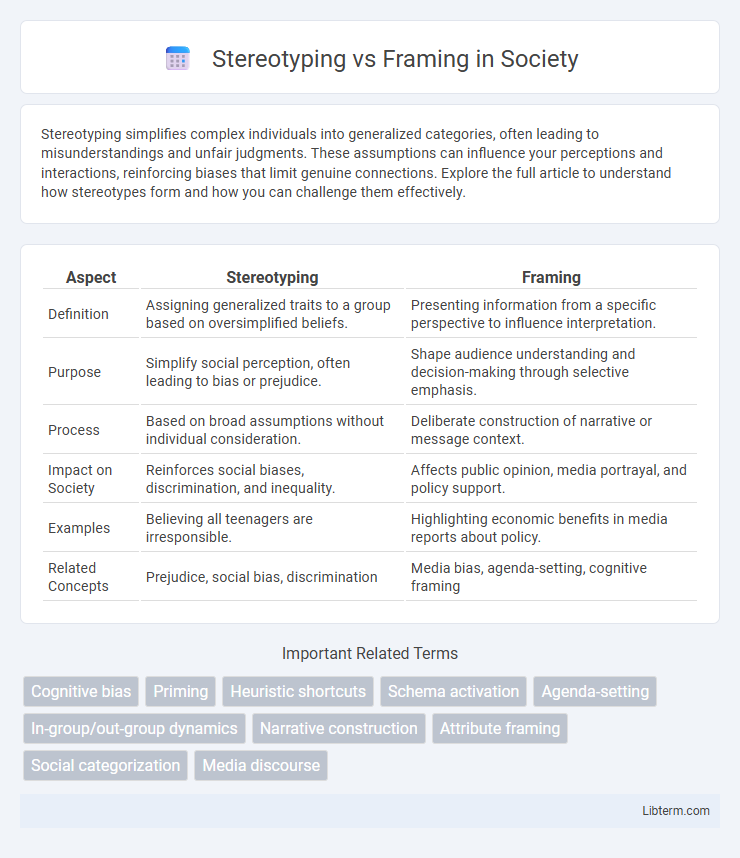Stereotyping simplifies complex individuals into generalized categories, often leading to misunderstandings and unfair judgments. These assumptions can influence your perceptions and interactions, reinforcing biases that limit genuine connections. Explore the full article to understand how stereotypes form and how you can challenge them effectively.
Table of Comparison
| Aspect | Stereotyping | Framing |
|---|---|---|
| Definition | Assigning generalized traits to a group based on oversimplified beliefs. | Presenting information from a specific perspective to influence interpretation. |
| Purpose | Simplify social perception, often leading to bias or prejudice. | Shape audience understanding and decision-making through selective emphasis. |
| Process | Based on broad assumptions without individual consideration. | Deliberate construction of narrative or message context. |
| Impact on Society | Reinforces social biases, discrimination, and inequality. | Affects public opinion, media portrayal, and policy support. |
| Examples | Believing all teenagers are irresponsible. | Highlighting economic benefits in media reports about policy. |
| Related Concepts | Prejudice, social bias, discrimination | Media bias, agenda-setting, cognitive framing |
Understanding Stereotyping: Definition and Origins
Stereotyping involves categorizing individuals or groups based on generalized attributes, often leading to oversimplified and inaccurate perceptions. Its origins trace back to cognitive processes where the human brain simplifies vast amounts of social information to quickly identify patterns and reduce complexity. Understanding stereotyping requires examining how these mental shortcuts influence attitudes and behaviors, often reinforcing social biases and prejudices.
What is Framing? Key Concepts Explained
Framing refers to the way information is presented to influence perception and interpretation by emphasizing certain aspects while omitting others. Key concepts in framing include selection, salience, and spin, which shape audience understanding by highlighting specific values, facts, or narratives. This cognitive process plays a critical role in media, politics, and communication by guiding how people process and respond to issues or events.
Stereotyping vs Framing: Core Differences
Stereotyping involves fixed, oversimplified beliefs about a group, often leading to prejudiced attitudes, while framing shapes the presentation and interpretation of information to influence perception and decision-making. Stereotyping categorizes individuals based on generalized traits, creating rigid mental schemas, whereas framing selectively highlights certain aspects of a message to guide audience understanding. Core differences lie in stereotyping's reliance on cognitive biases and social categories, contrasted with framing's strategic communication techniques designed to modify context and meaning.
The Psychology Behind Stereotyping and Framing
Stereotyping involves cognitive shortcuts that categorize individuals or groups based on perceived traits, often leading to biased judgments and reinforcing social schemas. Framing influences perception by shaping how information is presented, thus affecting decision-making and emotional responses through selective emphasis and contextual cues. Both processes engage psychological mechanisms such as heuristics, cognitive biases, and social identity, impacting attitudes, behavior, and communication effectiveness.
How Media Shapes Perceptions: Stereotypes vs Frames
Media shapes perceptions by using stereotypes, which simplify complex social identities into fixed, oversimplified traits, reinforcing existing biases and limiting diverse representation. Framing, on the other hand, strategically highlights certain aspects of a story while downplaying others, influencing how audiences interpret events and issues. Both stereotyping and framing significantly impact public opinion by guiding cognitive shortcuts and emotional responses toward specific groups or topics.
Impacts of Stereotyping on Society
Stereotyping perpetuates harmful biases by simplifying complex social groups into fixed, generalized traits, leading to discrimination and social exclusion. This cognitive shortcut reinforces prejudice, limits individual potential, and undermines social cohesion by fostering division and misunderstanding. The widespread acceptance of stereotypes influences policy-making, media representation, and interpersonal relationships, exacerbating inequality and systemic injustice.
Framing Effects in Communication and Decision-Making
Framing effects in communication significantly influence decision-making by shaping how information is presented and perceived, impacting individuals' choices and attitudes. Different framing techniques, such as positive or negative frames, can alter risk assessment and preferences without changing the factual content. Understanding framing effects is crucial for marketers, policymakers, and communicators to guide behavior and opinion effectively.
Real-World Examples: Stereotyping and Framing in Action
Stereotyping in real-world scenarios often manifests in media where ethnic groups are repeatedly portrayed with fixed traits, such as the portrayal of Asians as academically elite, reinforcing simplistic generalizations. Framing shapes public perception by highlighting specific aspects of an event, like media coverage of protests that either emphasize violence or peaceful demonstrations, significantly influencing audience interpretation. Both processes affect social attitudes, with stereotyping limiting individual identity while framing guides opinion through selective presentation of information.
Overcoming Bias: Strategies to Avoid Stereotyping and Unfair Framing
Overcoming bias requires conscious efforts to recognize and challenge stereotypes by seeking diverse perspectives and verifying assumptions through evidence-based information. Implementing training programs on cultural competence and implicit bias helps individuals identify subconscious prejudices and promotes fair representation. Employing inclusive language and emphasizing context ensures accurate framing that respects individual differences and mitigates unfair generalizations.
Future Trends: Evolving Roles of Stereotyping and Framing
Future trends in stereotyping and framing reveal their evolving roles in shaping public opinion through increasingly sophisticated digital media algorithms and AI-driven content curation. Stereotyping is expected to become more nuanced, influenced by large data sets enabling personalized narrative reinforcement, while framing techniques will leverage immersive technologies like virtual reality to create more compelling, interactive experiences. These advancements highlight a shift toward dynamic, context-sensitive communication strategies that could both challenge and perpetuate existing biases in society.
Stereotyping Infographic

 libterm.com
libterm.com